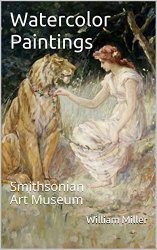Watercolor Paintings: Smithsonian Art Museum
- Добавил: harun54
- Дата: 30-10-2022, 11:01
- Комментариев: 0
 Название: Watercolor Paintings: Smithsonian Art Museum
Название: Watercolor Paintings: Smithsonian Art MuseumАвтор: William Miller
Издательство: Smithsonian Art Museum
Год: 2020
Формат: EPUB, AZW3
Размер: 15 Мб
Язык: английский / English
Watercolor is a painting method in which the paints are made of pigments suspended in a water-based solution. Watercolor refers to both the medium and the resulting artwork. The traditional and most common support—material to which the paint is applied—for watercolor paintings is paper. Other supports include papyrus, bark papers, plastics, vellum, fabric, wood and canvas. Watercolor paper is often made entirely or partially with cotton. This gives the surface the appropriate texture and minimizes distortion when wet. Watercolors are usually translucent, and appear luminous because the pigments are laid down in a pure form with few fillers obscuring the pigment colors. Watercolors can also be made opaque by adding Chinese white. Watercolor painting is extremely old, dating perhaps to the cave paintings of paleolithic Europe, and has been used for manuscript illustration since at least Egyptian times but especially in the European Middle Ages.
However, its continuous history as an art medium begins with the Renaissance. The German Northern Renaissance artist Albrecht Drurer (1471–1528), who painted several fine botanical, wildlife, and landscape watercolors, is generally considered among the earliest exponents of watercolor. An important school of watercolor painting in Germany was led by Hans Bol (1534–1593) as part of the Drurer Renaissance.Despite this early start, watercolors were generally used by Baroque easel painters only for sketches, copies or cartoons (full-scale design drawings). Notable early practitioners of watercolor painting were Van Dyck (during his stay in England), Claude Lorrain, Giovanni Benedetto Castiglione, and many Dutch and Flemish artists. However, botanical illustration and wildlife illustration perhaps form the oldest and most important traditions in watercolor painting. Botanical illustrations became popular during the Renaissance, both as hand-tinted woodblock illustrations in books or broadsheets and as tinted ink drawings on vellum or paper. Botanical artists have traditionally been some of the most exacting and accomplished watercolor painters, and even today, watercolors—with their unique ability to summarize, clarify, and idealize in full color—are used to illustrate scientific and museum publications. Wildlife illustration reached its peak in the 19th century with artists such as John James Audubon, and today many naturalist field guides are still illustrated with watercolor paintings.
[related-news] [/related-news]
Внимание
Уважаемый посетитель, Вы зашли на сайт как незарегистрированный пользователь.
Мы рекомендуем Вам зарегистрироваться либо войти на сайт под своим именем.
Уважаемый посетитель, Вы зашли на сайт как незарегистрированный пользователь.
Мы рекомендуем Вам зарегистрироваться либо войти на сайт под своим именем.
